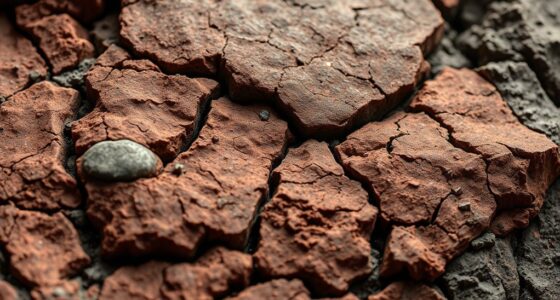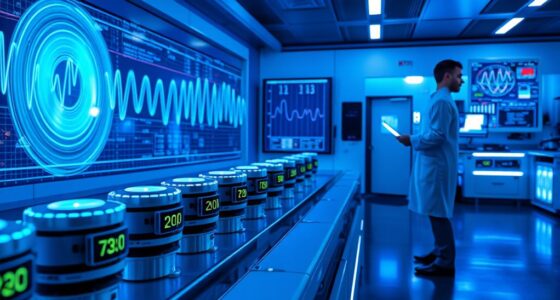NASA’s new asteroid tugboat mission aims to transform planetary defense by using a spacecraft with advanced propulsion, like ion thrusters, to gently steer hazardous asteroids away from Earth. This approach lets you control asteroid trajectories precisely, depending on their composition, without relying on impact. By focusing on continuous, low-thrust adjustments, NASA’s mission seeks scalable, proactive solutions for planetary safety. If you keep exploring, you’ll discover how this innovative strategy could redefine our ability to protect Earth.
Key Takeaways
- The mission introduces a scalable, precise asteroid deflection method using gentle propulsion techniques, shifting from reactive to proactive planetary defense.
- It leverages advanced propulsion systems like ion thrusters for continuous, low-thrust asteroid trajectory adjustments.
- Understanding asteroid composition is crucial to selecting appropriate deflection techniques, improving safety and effectiveness.
- The spacecraft’s ability to carry scientific instruments enhances asteroid analysis, informing better intervention strategies.
- This innovative approach could revolutionize planetary defense by enabling reliable, controlled asteroid redirection, reducing impact threat risk.

Have you ever wondered how NASA plans to protect Earth from potentially hazardous asteroids? The agency is developing an innovative mission centered around a spacecraft designed to gently but effectively alter an asteroid’s course. This mission hinges on advanced spacecraft propulsion systems and a deep understanding of asteroid composition. These elements are crucial because they determine how the spacecraft interacts with its target and how successful the deflection will be.
NASA’s asteroid deflection mission relies on advanced propulsion and detailed asteroid analysis for effective planetary defense.
The spacecraft propulsion technology is at the heart of this mission. Unlike traditional rockets that rely on chemical propulsion, NASA is exploring more efficient options like ion thrusters or solar-electric propulsion. These systems offer continuous, low-thrust acceleration over long periods, making them ideal for precise navigation and gradual asteroid deflection. With this technology, the spacecraft can approach the asteroid carefully, maintain control, and carry out maneuvers that would be impossible with conventional engines.
The propulsion system’s efficiency also allows the spacecraft to carry more payload, including instruments for analyzing the asteroid’s properties, and to operate over extended periods without needing frequent refueling. Additionally, understanding the propulsion technology used in the spacecraft is essential for developing more effective planetary defense strategies.
Understanding asteroid composition is equally essential. Not all asteroids are the same; some are solid rock, while others are loose aggregates of dust and gravel, known as rubble piles. Some contain significant amounts of metals or ice. Knowing what the asteroid is made of guides the mission’s approach.
For example, a solid rock body might respond predictably to a kinetic impact or a gentle push, whereas a loosely bound rubble pile might absorb the impact differently, requiring a softer approach. NASA’s team plans to analyze the asteroid’s surface and internal structure before executing any deflection techniques, using onboard sensors and remote observations.
These insights help determine the best method to nudge the asteroid onto a safer trajectory. This mission’s success relies on combining a sophisticated propulsion system with detailed knowledge of the asteroid’s makeup. By doing so, NASA aims to develop a reliable, scalable approach to planetary defense.
The goal isn’t just to bump an asteroid slightly but to ensure that Earth remains safe from potential impacts. This approach could revolutionize how we handle planetary defense, shifting from reactive measures to proactive, precise interventions. In essence, NASA’s new asteroid tugboat mission promises a smarter, more controlled way to prevent catastrophe, leveraging cutting-edge propulsion and asteroid science to protect our planet.
Frequently Asked Questions
How Will the Tugboat Navigate Around Unpredictable Asteroid Surfaces?
You’ll need to carefully assess the asteroid’s surface stability before attempting navigation, as unpredictable surfaces pose significant challenges. The tugboat will likely use advanced sensors and real-time data to adapt its approach, ensuring it can respond to surface variations.
What Are the Safety Protocols for Potential Asteroid Fragmentation?
Imagine safety protocols as a shield against chaos. When it comes to asteroid fragmentation, you’re protected by strict procedures designed to prevent unintended consequences.
These protocols include real-time monitoring, controlled engagement, and contingency plans to manage debris or unexpected splits. You’re guided by established safety standards to guarantee that even if fragmentation occurs, it’s controlled and doesn’t threaten Earth, keeping planetary defense firmly in your hands.
How Does This Mission Compare to Previous Planetary Defense Strategies?
You’ll find this mission innovative because it uses advanced propulsion technology to gently redirect asteroids, unlike earlier strategies that focused on deflection or destruction.
What Collaborations Are Involved Beyond NASA?
Have you considered who else plays a role in planetary defense? Beyond NASA, you’ll find international partnerships and private sector collaborations working together.
These alliances enable sharing crucial data, developing new technologies, and coordinating efforts to protect Earth. By pooling resources and expertise, they enhance our ability to respond swiftly to threats.
Isn’t it reassuring to know that such global teamwork exists, strengthening our planetary safety net?
Could the Tugboat Be Repurposed for Other Space Missions?
You might wonder if the asteroid tugboat could be repurposed for other space missions. Absolutely, it could support asteroid mining by redirecting resources or assist deep space exploration by acting as a versatile propulsion platform.
Its adaptable design makes it suitable for tasks like cargo transport or satellite servicing, expanding its role beyond planetary defense. This flexibility could open new possibilities in space exploration and resource utilization.
Conclusion
You’re standing at the brink of a new era in planetary defense, where NASA’s asteroid tugboat could be the lighthouse guiding us safely through cosmic storms. This mission isn’t just a leap forward; it’s a bold stroke in painting a future where we can steer away from disaster. With every step, you realize that this innovative approach could turn the tide, transforming what once seemed impossible into a beacon of hope shining brightly in the vast darkness of space.










